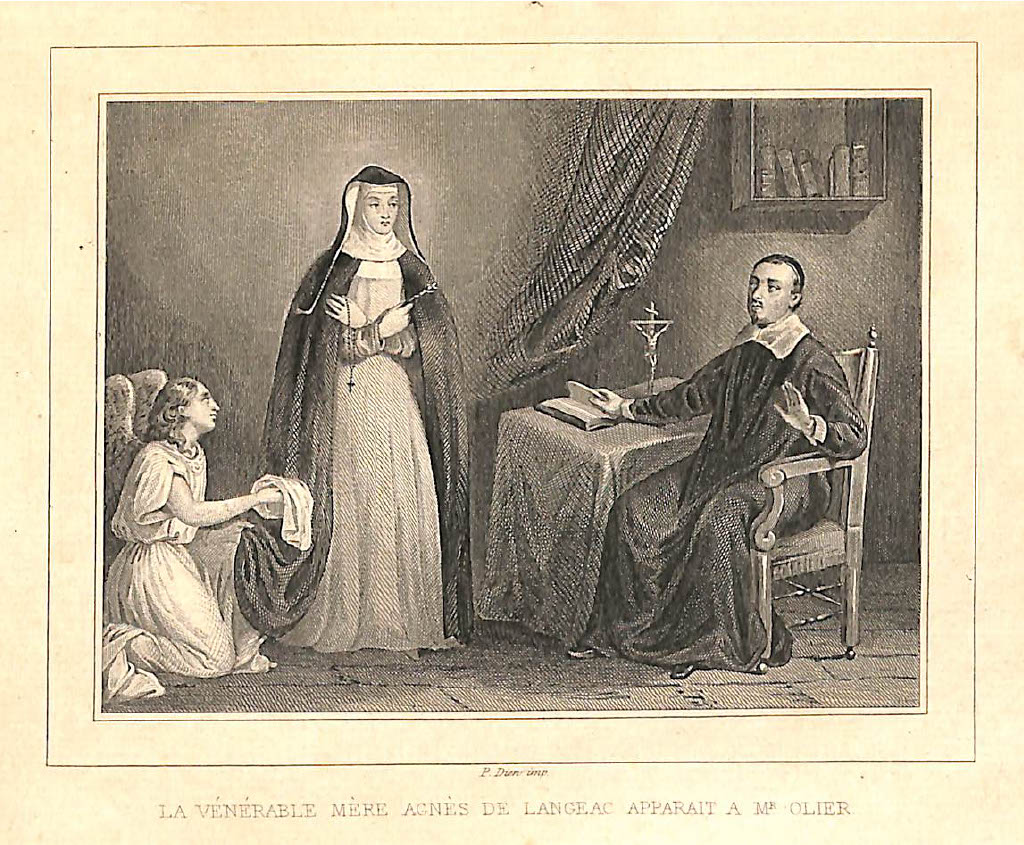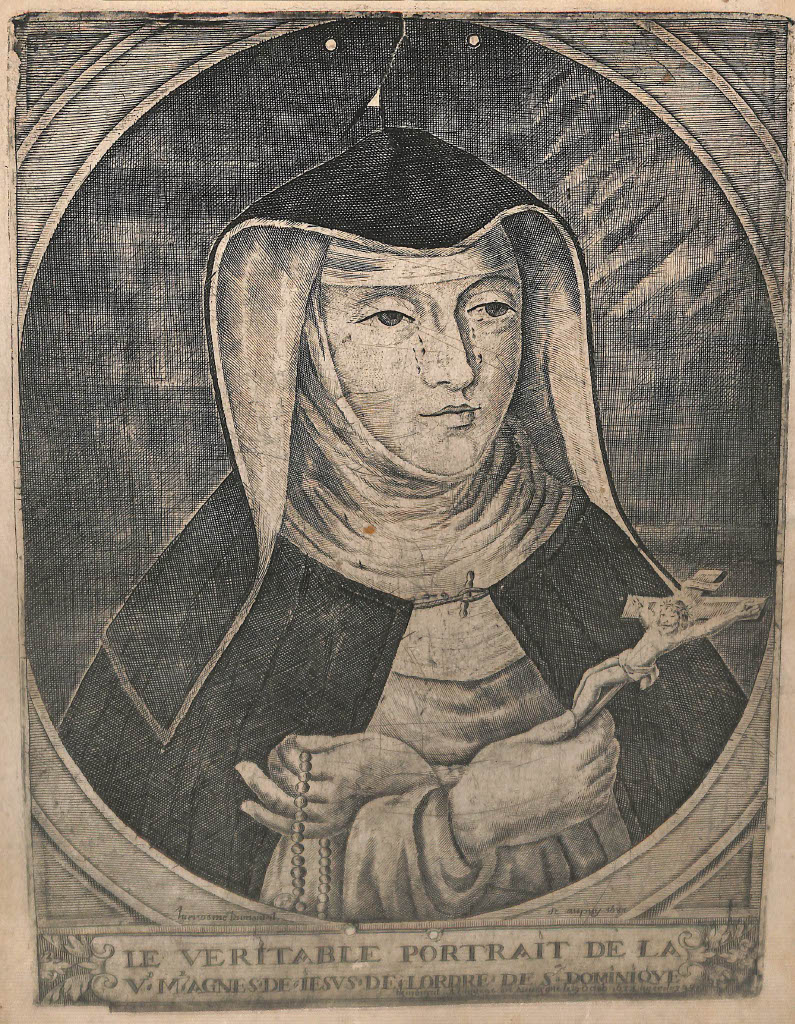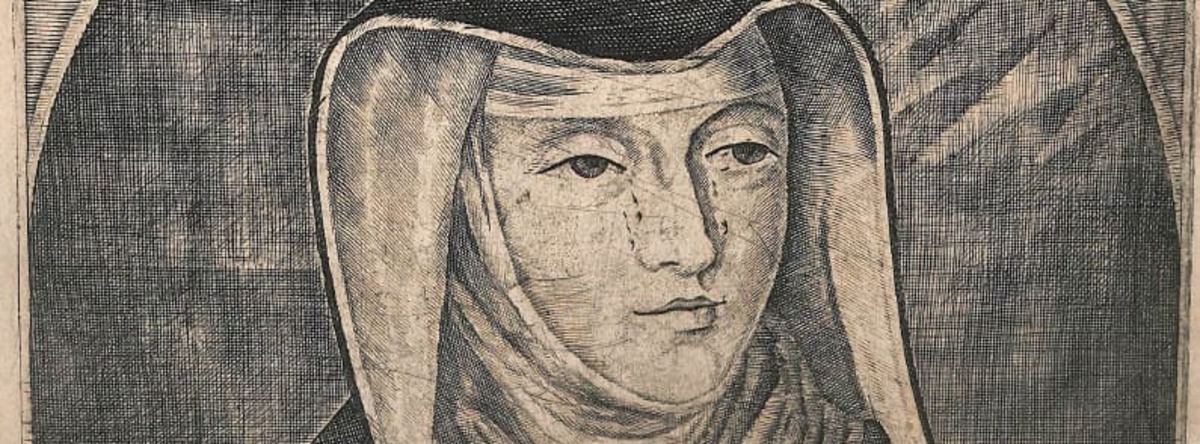Mss 253-254: The Admirable Life of Sister Agnes of Jesus [by a religious of the Congregation of Saint Maur in Paris, 1647]
From archival manuscripts 253 & 254
The attribution of the anonymous manuscript of The Admirable Life of Sister Agnes of Jesus has always raised questions. One of the endpapers bears a note which indicates: “by a religious of the Congregation of Saint Maur who could be Dom Grégoire Tarrisse” - a congregation of which the latter was indeed the Superior General between 1630 and 1648. Another note appears on the title page, this time, indicating the following: “by a religious of the Order of Saint Benedict.” My predecessor at the Archives of Saint Sulpice, Father Irénée Noye, also attributed it to a Benedictine of the Congregation of Saint Maur, but he leaned more towards Dom Henri-Damien Lerminier.
We preserve this Life of Agnes in the Archives of Saint Sulpice in Paris. It consists of two volumes with the catalogue numbers, ms. 253 and ms. 254.
The first volume of this Life contains three books which paint the spiritual portrait of the Dominican nun, from her birth until her entry into the Monastery in Langeac. The second volume continues the story from her solemn profession until her death at the age of 32, while emphasizing her virtues and her spiritual life within the monastery.
Both volumes contain passages which refer to the encounter with Jean-Jacques Olier, which took place in 1634, a few months before her death. Here is the transcription of that encounter:
Extracts from the report of the encounter between Sister Agnes of Jesus and Jean-Jacques Olier in 1634 :
MS 253 folios 4-5 :
Preface.
[...] The Bishop of Saint-Flour, now in Rodés [sic], sent some years ago to Father Olier, Pastor of Saint Sulpice in Paris, the memoirs of the life of this holy woman, with a request to view them, make adjustments, and publish them. The pastor placed them in my hands with several letters and other papers concerning this same life in order to use them to formulate a history, as I have done.
Father Panassière was the main writer of the extraordinary actions and virtues of Agnes, as he was her ordinary confessor. Archpriest Martinon, whose hand-written memoirs I have, was equally diligent while he was charged with this task. Father Ollier [sic] noticed her very special virtues and graces in the short time that he communicated with her and received her inmost secrets. The nuns of Langeac shared some information about her. Some of her companions in normal society, when she was a secular, and who are now nuns, have written some of them that I also possess. And that is where the memoirs that are the subject of this book come from. For the esteem in which Agnes has been held and the approbation she merited from people just as qualified in their condition since they are religious and prudent in their judgment, here are the following […]
 Engraving ordered by Étienne-Michel Faillon, PSS for his edition of The Life of M. Olier in 1841
Engraving ordered by Étienne-Michel Faillon, PSS for his edition of The Life of M. Olier in 1841
Ms 254 folios 267-269 :
Sixth Book. Chapter 10. Continuation of the same subject.
[...] We are going to close this chapter and this book with the account of several graces and marvels which concur on the same subject and for the same person. He still lives in those feelings and the very happy effects of the Charity of this incomparable daughter. The Virgin, appearing to him one day all dressed in glory, said to him: “Pray my Son for such and such” whom she named and who then was plunged into the darkness of a licentious [sic] and criminal life. So he said, telling me all this on the express command of his director. Mother Agnes had never seen or known this person, nor heard of him, being about a hundred leagues away. However, she did not cease, from that moment, to pray and cry for the complete conversion of this soul which was recommended to her from such a good source. Three years passed in these tears. Heaven touched his libertine heart in favor of this charitable and innocent penitent. Here he was on retreat where he studied his complete divorce from the world and its vanities and made himself open to all the graces necessary for a virtuous ecclesiastic. Meanwhile, Agnes appeared to him on two different occasions, a crucifix in one hand and a rosary in the other. Her face was all bathed in tears, and an angel near her carried her long coat in one hand, and in the other, held a handkerchief with which he collected her tears. And he heard these words: “I cry for you.”
He, highly afflicted at the sight of that majestic face full of tears, not knowing who it was and doubting that it was the Blessed Virgin, remained in suspense and ignorance until, passing one day by the town of Langeac, he heard rumors of the renowned virtue and graces of Mother Agnes, which drew him to the gate of her Monastery. There, seeing her, he recognized her and learned from her what had happened and how she was burdened with his sins and had done penance for him during a three-year period. She gave him the rosary, the crucifix, and the handkerchief which he had seen in his apparition, and the angel. Even after her death, as we will say in the following book, we are going to see this great light set on the side of this world in order to rise to the beautiful eternity of the other [...]
Résumé of the life of Agnes of Langeac
« Whoever has God has everything! » This expression from Blessed Agnes of Jesus summarizes perfectly her sense of religious vocation.
It was in Le Puy-en-Velay that little Agnes Galand was born on November 17, 1602, in a city strongly marked for several centuries by pilgrimages and Marian devotion. Baptized the next day, her parents took charge of her religious education, which they entrusted to the schoolmaster Pierre Vigne-Sole, as well as to Father Jacques Larieu, a Jesuit, who would be her first confessor.
Agnes took the vow of virginity at the age of 7 after an apparition of Saint Francis of Assisi surrounded by flames of love in the Church of Saint-Laurent des Prêcheurs, which she then frequented in Le Puy. The following year, she devoted herself entirely to Mary in front of the altar of the cathedral. According to the custom of the time, her father interrupted her studies when she was 8 years old to introduce her to lace work in the family home.
She was 17 when Father Esprit Panassière, of the order of Saint Dominic, arrived in Le Puy and became her new confessor in 1620. It was this Dominican who would later write the Memoirs of the Life of Agnes, one of the main sources for her biography, as the preface to manuscript 253 we are studying here seems to confirm. The Author claims to have referred to the Memoirs of Father Panassière to write this Life.
The following year, in 1621, Agnes was admitted to the Third Dominican Order. She was then 19 years old. Her penchant for the contemplative life pushed her, however, to go further by joining the Dominican Sisters of the Monastery of Langeac on September 24, 1623. The monastery and the community of sisters residing there had just been founded. A few days later, she took the habit as a lay sister before making her religious profession on February 2, 1625.
The Bishop of Saint-Flour at the time of these events, Monsignor Charles de Noailles, who ruled from 1609 to 1647, knew the young Agnes Galand well. This is why he intervened personally with the Dominicans for her integration as a lay sister within the newly founded Monastery of Saint Catherine in Langeac.
The Author tells us in the preface of his manuscript that the said prelate of Saint-Flour became bishop of Rodez at the time when he began writing his work. This allows us to place the writing of his text between April 8, 1647 and March 27, 1648, dates corresponding to the episcopate of Bishop Charles de Noailles for the Diocese of Rodez.
From the time she entered the monastery, Agnes Galand, who took the religious name of Agnes of Jesus, went from cook to cantor, before being appointed novice mistress during Lent 1626. At the same time, her confessor Father Panassière, as well as her spiritual director Father Arnauld Boyre, of the Society of Jesus, left Le Puy. The writings of Father Arnauld Boyre would therefore constitute the second living testimony to the life of Agnes.
Agnes was elected Prioress of the Monastery in Langeac on September 23, 1627. She was only 25 years old.
In 1631, the Virgin Mary appeared to her and asked her to pray for the conversion of the Abbot of Pébrac, whose abbey was located in a neighboring town to the south of Langeac. However, the commendatory abbot of Pébrac was none other than Jean-Jacques Olier who, at the time of Agnes's vision, was being forming for clerical status by frequenting the circle of Vincent de Paul. After his priestly ordination, which took place in Paris in 1633, Jean-Jacques Olier would twice see apparitions of a nun wearing a Dominican habit, a crucifix and a rosary in each hand. The nun was accompanied by an angelic creature who was none other than her guardian angel. He wore her coat and held her handkerchief in his hand, the very one that she used to wipe away her tears when she prayed for the abbot's conversion.
But it was not until 1634 that Father Olier and Mother Agnes would meet. While traveling through the region to evangelize the rural populations of Auvergne, according to the movement initiated by Saint Vincent de Paul, Olier heard of the reputation for holiness of Agnes de Langeac and decided to go to Saint Catherine of Siena Monastery. Once there, he clearly recognized, through the gate of the parlor, the face of the one who had appeared to him during his visions in Paris. She then told him how the Blessed Virgin had appeared to her 3 years earlier, asking her to pray for the conversion of the abbot.
From June to October 1634, Olier came to talk many times with Agnes of Jesus in the parlor of the Monastery of Saint Catherine. Shortly after the departure of Olier, who was to return to Paris, Agnes fell seriously ill and joined Christ, “her Spouse,” on October 19, 1634.
If the Memoirs composed by Fathers Panassière and Boyre constitute the first living testimonies of the Life of Agnes, it is to Charles de Lantages that we owe the first publication of a biography in 1665 in good and due form. Charles de Lantages was a Sulpician from the start. It was he who was sent in 1653 by Jean-Jacques Olier to take charge of the seminary in Puy, of which he became the first Superior, to respond to the request of the local bishop, Henri Cauchon de Maupas. The biography of Lantages has the advantage of recreating the story of the events in the life of Mother Agnes in a precise manner, thus completing the more spiritual portraits of the stories composed by Fathers Panassière and Boyre.
The iconography of Blessed Agnes of Jesus was strongly marked by the story of her meeting with Jean-Jacques Olier, as can be seen in the engraving below which represents her weeping and praying for the conversion of the young Olier. She has since been depicted with a rosary and a crucifix, attributes which she was wearing when she appeared to Father Olier in 1631.
 DUMONTEIL[H] Jérôme (1687), The true portrait of the Venerable Mother Agnes of Jesus. Etching, 36,7 x 27 cm. France, Paris, Archives de Saint-Sulpice
DUMONTEIL[H] Jérôme (1687), The true portrait of the Venerable Mother Agnes of Jesus. Etching, 36,7 x 27 cm. France, Paris, Archives de Saint-Sulpice
Mr. Zakaria HILAL, Archivist of the Society of the Priests of Saint Sulpice (Paris)
Translated by Rev. Ronald D. Witherup, P.S.S.



